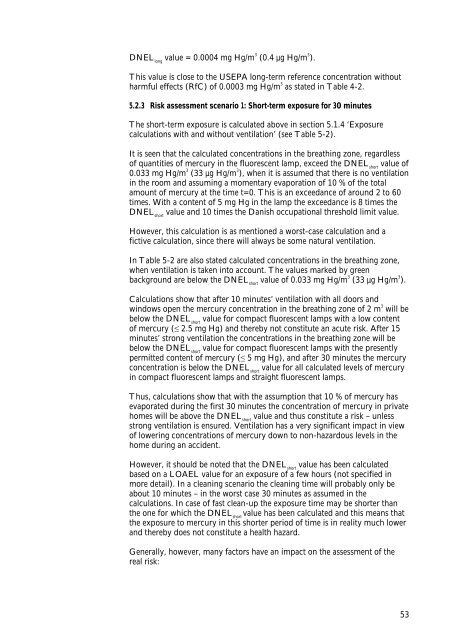No. 104 - Miljøstyrelsen
No. 104 - Miljøstyrelsen
No. 104 - Miljøstyrelsen
Create successful ePaper yourself
Turn your PDF publications into a flip-book with our unique Google optimized e-Paper software.
DNEL long value = 0.0004 mg Hg/m 3<br />
(0.4 µg Hg/m 3<br />
).<br />
This value is close to the USEPA long-term reference concentration without<br />
harmful effects (RfC) of 0.0003 mg Hg/m 3 as stated in Table 4-2.<br />
5.2.3 Risk assessment scenario 1: Short-term exposure for 30 minutes<br />
The short-term exposure is calculated above in section 5.1.4 ‘Exposure<br />
calculations with and without ventilation’ (see Table 5-2).<br />
It is seen that the calculated concentrations in the breathing zone, regardless<br />
of quantities of mercury in the fluorescent lamp, exceed the DNEL short value of<br />
0.033 mg Hg/m 3 (33 µg Hg/m 3 ), when it is assumed that there is no ventilation<br />
in the room and assuming a momentary evaporation of 10 % of the total<br />
amount of mercury at the time t=0. This is an exceedance of around 2 to 60<br />
times. With a content of 5 mg Hg in the lamp the exceedance is 8 times the<br />
DNEL short value and 10 times the Danish occupational threshold limit value.<br />
However, this calculation is as mentioned a worst-case calculation and a<br />
fictive calculation, since there will always be some natural ventilation.<br />
In Table 5-2 are also stated calculated concentrations in the breathing zone,<br />
when ventilation is taken into account. The values marked by green<br />
background are below the DNEL short value of 0.033 mg Hg/m 3 (33 µg Hg/m 3 ).<br />
Calculations show that after 10 minutes’ ventilation with all doors and<br />
windows open the mercury concentration in the breathing zone of 2 m 3 will be<br />
below the DNEL short value for compact fluorescent lamps with a low content<br />
of mercury (≤ 2.5 mg Hg) and thereby not constitute an acute risk. After 15<br />
minutes’ strong ventilation the concentrations in the breathing zone will be<br />
below the DNEL short value for compact fluorescent lamps with the presently<br />
permitted content of mercury (≤ 5 mg Hg), and after 30 minutes the mercury<br />
concentration is below the DNEL short value for all calculated levels of mercury<br />
in compact fluorescent lamps and straight fluorescent lamps.<br />
Thus, calculations show that with the assumption that 10 % of mercury has<br />
evaporated during the first 30 minutes the concentration of mercury in private<br />
homes will be above the DNEL short value and thus constitute a risk – unless<br />
strong ventilation is ensured. Ventilation has a very significant impact in view<br />
of lowering concentrations of mercury down to non-hazardous levels in the<br />
home during an accident.<br />
However, it should be noted that the DNEL short value has been calculated<br />
based on a LOAEL value for an exposure of a few hours (not specified in<br />
more detail). In a cleaning scenario the cleaning time will probably only be<br />
about 10 minutes – in the worst case 30 minutes as assumed in the<br />
calculations. In case of fast clean-up the exposure time may be shorter than<br />
the one for which the DNEL short value has been calculated and this means that<br />
the exposure to mercury in this shorter period of time is in reality much lower<br />
and thereby does not constitute a health hazard.<br />
Generally, however, many factors have an impact on the assessment of the<br />
real risk:<br />
53

















